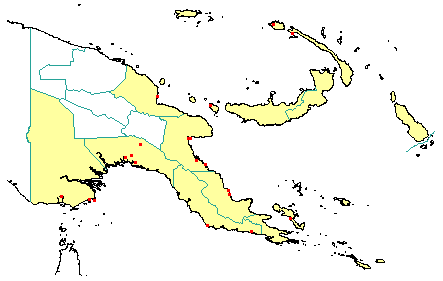
in PNGplants database
PNGTrees – Xylocarpus granatum K.D.Koenig |
Barry Conn (NSW) & Kipiro Damas (LAE).
Copyright held by the authors, Royal Botanic Gardens and Domain Trust, and Papua New Guinea National Herbarium
Der Naturforscher (Halle) 20 (1784)
Other Literature: M. Percival and J.S. Womersley, Floristics and Ecology of the Mangrove Vegetation of Papua New Guinea 90 (1975) Fig. 67-68.
Field Characters: Large trees or small trees 3-8(-22) m high. Bole almost cylindrical 30-40(-68) cm diam.; crooked bole up to 10 m high; buttresses absent or present up to 0.5 m high; spines absent; aerial roots present appearing above the soil, sinuous and plate-like; stilt roots absent. Bark pale brown or brownish green, smooth or slightly rough, slightly pustular or scaly or flaky slightly flaky, leaving paler yellow-brown areas; lenticels finely elongated vertically or irregular; subrhytidome green; bark thickness <25 mm thick, 4.0-6.0 mm thick; blaze consisting of one layer; faintly to non-aromatic; outer blaze red or pink, with stripes as fine concentric white lines or markings absent, fibrous; inner blaze red or pink, with stripes as fine concentric white lines or markings absent, fibrous; exudate absent. Terminal buds not enclosed by leaves; complex hairs absent; stinging hairs absent; mature twig without hairs.
Leaves: Spaced along branches <internodes readily visible>. Leaves spiral, compound; petiole present 15-30 mm long, not winged, attached to base of leaf blade <not peltate>, not swollen; leaves sometimes with two leaflets, sometimes with three leaflets, pinnate usually with 4-6 leaflets, or rarely with one leaflet; petiolule not swollen or slightly swollen <at tip, or base, or both> rachis absent or usually present, not winged, slightly swollen at either end or not swollen; leaves without a terminal leaflet, each leaflet broadest at or near middle or sometimes broadest above middle, (5.5-) 10.0-14.0 cm long, (2.5-) (very uncommon) 4.5-6.5 cm wide, leaflets opposite, slightly asymmetric apex rounded to very obtuse; venation pinnate <secondary veins arising from the midrib along its length>, secondary veins open <spaced far apart to easily see tertiary veins>, not prominent, but visible, intramarginal veins absent; lower surface pale green, upper surface dull green, hairs absent; oil dots absent; domatia absent; stipules absent.
Flowers: Inflorescence axillary <from between a leaf and branch>. Flowers on a branched axis; flowers bisexual, stalked pedicel 4-8(-10) mm long, with many planes of symmetry <actinomorphic>, 7.0 mm long, large (>10 mm diam.) 15 mm diam.; perianth present, with distinct sepals and petals, cream-coloured or pink; inner perianth 4, all joined; stamens 8, filaments present joined together, joined <connate> to form a staminal tube 2.5-5 mm long, white with pink tinge, or yellowish to orange, joined to perianth <epipetalous/episepalous> ovary superior <seated above petals and sepals; hypogenous>, carpels joined (when more than one) <syncarpous>, locules usually 4; styles solitary <including joined together> 1-2 mm long, 1.
Fruits: Fruits arranged on branched axis. Fruit 10-20 mm long, (10.0-) 20.0-40.0 (-50.0) mm diam., fruit brownish green or brown, not spiny, slightly fleshy, simple. Seeds 4-sometimes-5, much more than 10 mm long 7-10 mm long, not winged, as wide as long, 1-10 mm diam. 7-10 mm wide.
Distribution: Milne Bay, Bougainville, Manus, New Ireland, New Britain, Northern, Gulf, Central, Papuan Islands, Morobe, Madang & Western.
 | Botanical records in PNGplants database |